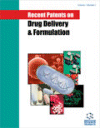-
s Increasing Progenitor Cell Proliferation in the Sub-Ventricular Zone: A Therapeutic Treatment for Progressive Multiple Sclerosis?
- Source: Recent Patents on Drug Delivery & Formulation, Volume 14, Issue 3, Sep 2020, p. 233 - 241
-
- 01 Sep 2020
Abstract
Introduction: The purpose of this study was to determine if pharmacological treatment could increase progenitor cell proliferation in the Sub-ventricular Zone of aged rats. Previous work had shown that increasing progenitor cell proliferation in this region correlated well (R2=0.78; p= 0.0007) with functional recovery in a damaged corpus callosum (white matter tract), suggesting that progenitor cell proliferation results in oligodendrocytes in this region. Methods: 10 month old male and female Sprague Dawley rats were fed the drugs for 30 days in cookie dough, then immunocytochemistry was performed on coronal brain sections, using Ki67 labeling to determine progenitor cell proliferation. Results: Female rats showed low endogenous (control) progenitor cell proliferation, significantly different from male rats (P<0.0001), at this age. Ascorbic Acid (20 mg/kg, daily for 30 days) increased progenitor cell proliferation overall, but maintained the innate gender difference in stem cell proliferation (P=0.001). Prozac (5 mg/kg, daily for 30 days) increased progenitor cell proliferation for females but decreased stem cell proliferation for males, again showing a gender difference (P<0.0001). Simvastatin (1 mg/kg for 30 days) also increased progenitor cell proliferation in females and decreased progenitor cell proliferation in males, leading to a significant gender difference. Discussion: The three drug combinations (fluoxetine, simvastatin, and ascorbic acid, patent # 9,254,281) led to ~ 4 fold increase in progenitor cell proliferation in females, while male progenitor cell proliferation was highest with 50 mg/kg ascorbic acid. However, the ascorbic acid increase in proliferation appears to be only on the sides of the ventricles, which is not the region that normally gives rise to oligodendrocytes. Conclusion: There are innate gender differences in progenitor cell proliferation at the Sub-Ventricular Zone at middle age in rats, possibly due to the loss of estrogen in females. We also see notable gender differences in progenitor cell proliferation in the Sub ventricular Zone in response to common drugs, such as fluoxetine, simvastatin and Vitamin C (ascorbic acid).


